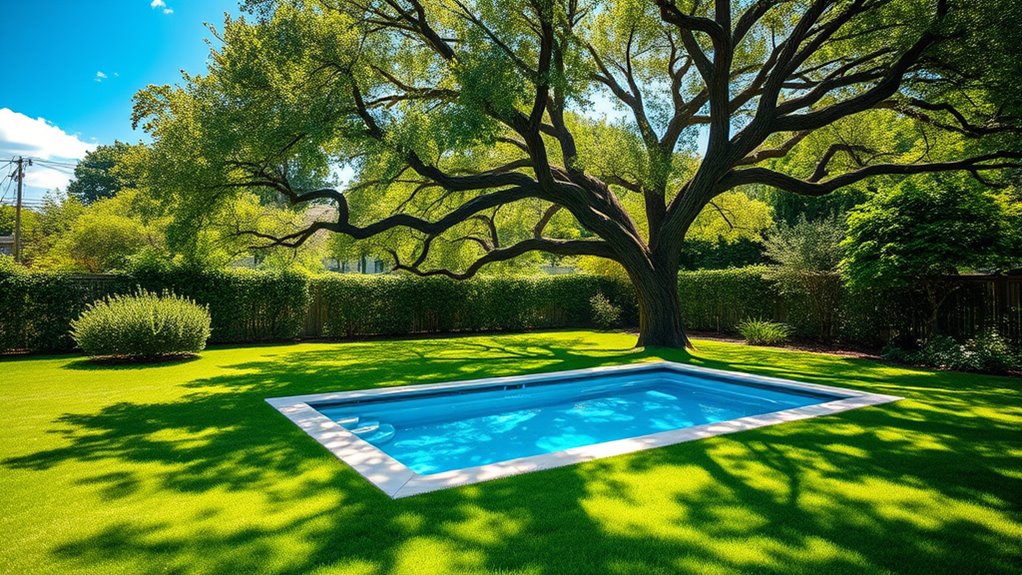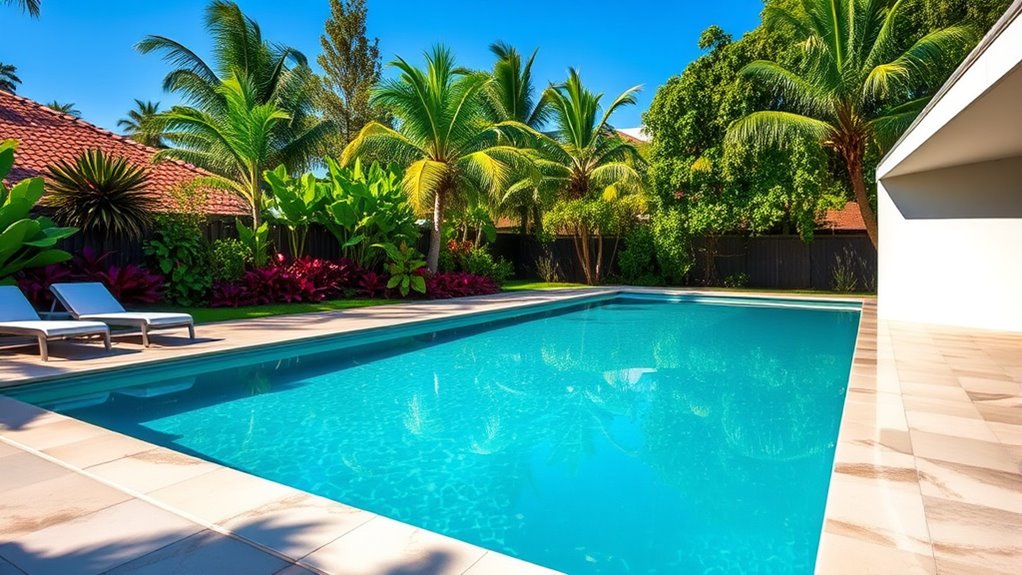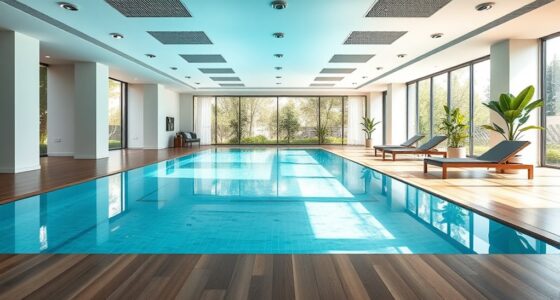For your endless pool, indoor spots like a basement, garage, or dedicated room offer climate control, privacy, and easy utility access, making year-round swimming a breeze. Outdoors, choose a level, well-drained area with plenty of sunlight away from trees and harsh weather. Avoid shaded spots, flood-prone areas, or locations with heavy debris risk. To guarantee the perfect setup, keep exploring for more tips on choosing the best location for your pool.
Key Takeaways
- Install indoors in a dedicated, climate-controlled space with adequate ceiling height and proper ventilation.
- Choose level, well-drained outdoor areas with easy access, plenty of sunlight, and minimal debris from trees.
- Avoid outdoor spots under trees to prevent leaves, sap, and branches clogging filters and equipment.
- Stay away from low-lying or flood-prone areas vulnerable to water pooling or storm damage.
- Select locations with convenient access to utilities and nearby changing areas for ease of use and maintenance.
Ideal Indoor Locations for Your Endless Pool

Indoor locations offer a convenient and versatile environment for your endless pool, especially if you want to enjoy swimming year-round regardless of weather. Your basement or dedicated indoor room provides a controlled climate, guaranteeing consistent water temperature and comfort. A garage or converted workshop can also work well, giving you privacy and easy access. When choosing an indoor space, ensure it has enough ceiling height for comfortable swimming and proper ventilation to manage humidity. Consider proximity to changing areas and easy access to utilities like water and electricity. You’ll also want a space that minimizes noise disruption and allows for proper lighting. An indoor location lets you swim whenever you want, without outdoor weather concerns, making it a practical choice for daily use. Proper indoor water quality management is essential to maintain clean and safe swimming conditions year-round.
Optimal Outdoor Spots and Areas to Avoid

Choosing the right outdoor spot for your endless pool can enhance your swimming experience, but some areas are best avoided to prevent issues like debris, harsh weather, or damage. Avoid placing your pool under trees, as falling leaves, branches, and sap can clog filters and require frequent cleaning. Steer clear of exposed areas prone to heavy wind or rain, which can cause debris buildup or even damage the structure. Don’t install your pool in a low-lying spot where flooding or pooling might occur during storms. Additionally, avoid shaded areas with limited sunlight, as this can promote algae growth. Make sure the location has easy access for maintenance and is level for proper installation. Choosing wisely helps you enjoy your outdoor endless pool without unnecessary headaches.
Frequently Asked Questions
Can I Install an Endless Pool on a Rooftop Deck?
Yes, you can install an Endless Pool on a rooftop deck, but you must guarantee the structure can support the weight. Consult a structural engineer to verify load capacity and get the necessary permits. Consider factors like access, electrical wiring, and safety barriers. Proper planning ensures your rooftop pool is safe, stable, and enjoyable without risking damage or accidents.
What Are the Noise Considerations for Outdoor Installations?
You should consider noise levels when installing your outdoor endless pool, especially if near neighbors or quiet spaces. The pump and filtration system can generate sound that might disturb others or disrupt your relaxation. To minimize noise, opt for a location away from bedrooms or quiet zones, and consider barriers or soundproofing options. Regular maintenance and choosing quieter equipment models can also help keep noise levels manageable.
How Much Space Is Needed for Maintenance Access?
Think of maintenance access like a doorway to your backyard oasis. You’ll need at least 2 to 3 feet of clearance around your pool for easy upkeep. This space lets you clean filters, check equipment, and perform repairs without hassle. Make sure there’s enough room on all sides—especially the front—to open panels and move equipment. Adequate space keeps maintenance smooth, so your pool stays pristine and ready whenever you need it.
Are There Specific Permits Required for Outdoor Pools?
Yes, you typically need permits for outdoor pools. You should check with your local building department or zoning office to find out the specific requirements in your area. Some places require permits for construction, electrical work, and plumbing. Failing to obtain the necessary approvals can lead to fines or having to remove your pool later. It’s best to start the permit process early to avoid delays and ensure everything is up to code.
What Are the Safety Concerns for Children Around Outdoor Pools?
Think of your outdoor pool as a treasure chest that kids can’t resist. To keep them safe, always supervise closely, install a secure fence with a self-latching gate, and use pool alarms. Remove toys and floats when not in use, and never leave children unattended. Regularly check filtration and safety equipment, and educate kids about pool rules. These steps act as a shield protecting your little explorers from potential hazards.
Conclusion
Remember, location is key—”a chain is only as strong as its weakest link.” Whether you choose an indoor or outdoor spot, pick a place that offers privacy, safety, and easy access. Avoid areas prone to extreme weather or heavy foot traffic. By choosing wisely, you’ll enjoy your endless pool for years to come and make the most of every invigorating swim. Don’t rush the decision—your perfect spot is out there waiting!









